
I was a shivering in bed on my first night in Mogadishu. At 3:30 am, I killed the air conditioner. Moments later, the room felt stuffier than a London subway. I got up and paced around, wondering if it was safe to keep the balcony door open.
A few months back, al-Shabab, an al-Qaeda faction, had stormed Jazeera Palace Hotel, where I was currently staying, and sprayed a group of Chinese diplomats with lead. Now the building was secured by a street blockade, a double-gated check-in, blastproof walls, two dozen armed men and Abdullah, the small, wiry gentleman with an AK-47 outside my door.
I took a peek into the corridor and caught Abdullah dozing off. He was balancing on a tiny wooden stool, with the rifle propped between his legs.
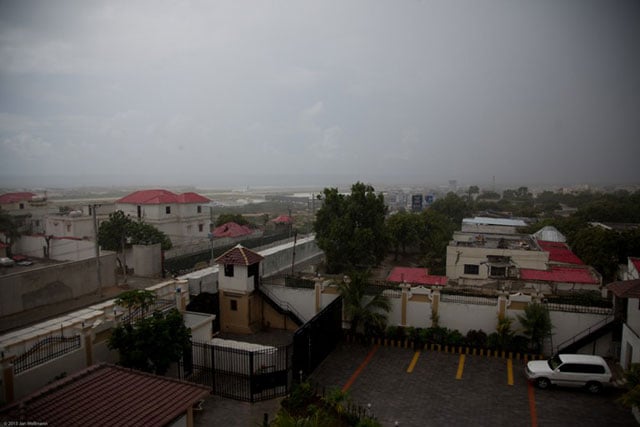 View from Jazeera Palace Hotel towards the Mogadishu International Airport. (Photo: Jan Wellmann)I was surprised to see his chair begin to gently vibrate, as if tapping Morse code on the cement floor. Seconds later, a set of massive, low-rumble turboprops shook the building. I rushed out to the balcony, expecting to see Con Air crash into the adjoining UN building, but only saw a dark, black shape swoop down to Mogadishu’s Aden Adde International Airport half a mile away. Whoever was piloting the craft had killed all navigation lights.
View from Jazeera Palace Hotel towards the Mogadishu International Airport. (Photo: Jan Wellmann)I was surprised to see his chair begin to gently vibrate, as if tapping Morse code on the cement floor. Seconds later, a set of massive, low-rumble turboprops shook the building. I rushed out to the balcony, expecting to see Con Air crash into the adjoining UN building, but only saw a dark, black shape swoop down to Mogadishu’s Aden Adde International Airport half a mile away. Whoever was piloting the craft had killed all navigation lights.
“What kind of birds drop into Mogadishu at 4 am without lights?” I felt compelled to ask my host, Hassan, the next morning. I was in town with an alternative energy delegation, presenting clean power options to Somali leaders and businessmen. Hassan was in charge of our arrangements and security. He knew Mogadishu inside out and was a fast thinker.
“Ah, you mean Big Brother?” Hassan smiled.
His grin made me curious. The Americans had a peculiar reputation in Mogadishu.
Capturing the White Pearl
Mogadishu, Somalia’s capital, was one of the Indian Ocean’s principal ports until the early 20th century. Its trading history goes back to ancient Egypt. Mogadishu prospered through its trade in gold, beeswax, ivory and an abundance of fruits, animals and other foods all across the world, providing immense wealth to the native Berbers and Arabs. The city’s inhabitants used a fraction of this wealth to build the beautiful pearl-white mosques and cathedrals of Mogadishu.
Today, Somalia is rife with drought, famine and war. Mogadishu lies in rubble. Tribal factions have deconstructed the city block by block, with rocket-propelled grenades and anti-aircraft guns over a period of two decades. At least 300,000 Somalis were killed in Mogadishu alone during the civil war, and another 1.1 million had to flee the country.
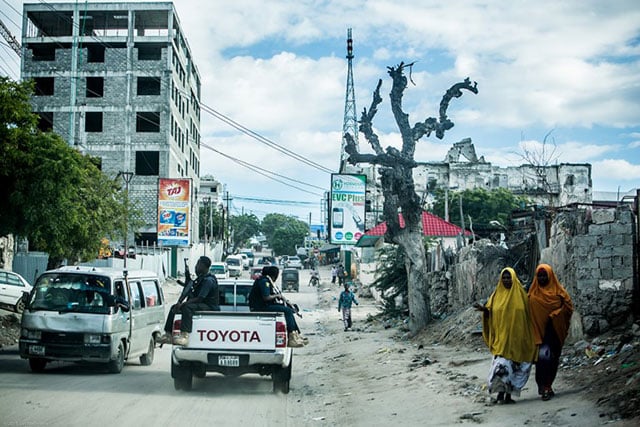 Mogadishu’s Bakaara Market, or what’s left of it. (Photo: Jan Wellmann)The city has no sewage system, waste management, energy infrastructure, population registry or ownership records. Random diesel generators provide fractional power to the privileged few. Travel inside Somalia is practically impossible, with much of the roadways, bridges and infrastructure destroyed. Al-Shabab still pops into town for surprise mayhem, forcing us to behold the view from behind bulletproof glass and a convoy of armed guards.
Mogadishu’s Bakaara Market, or what’s left of it. (Photo: Jan Wellmann)The city has no sewage system, waste management, energy infrastructure, population registry or ownership records. Random diesel generators provide fractional power to the privileged few. Travel inside Somalia is practically impossible, with much of the roadways, bridges and infrastructure destroyed. Al-Shabab still pops into town for surprise mayhem, forcing us to behold the view from behind bulletproof glass and a convoy of armed guards.
As we drove past the central marketplace, I was at first happy to see one brand new modern structure rise out of the ashes. But then my guide told me it’s the National Intelligence and Security Agency headquarters, established in 2013 “under CIA supervision.”
The gleaming building is symbolic of the new US influence in the region.
The official reason for the US presence in Somalia is the perennial war against terrorism. The real reason is oil.
Aside from training and building Somalia’s intelligence infrastructure, the Americans are building a new, secretive military base 70 kilometers southwest of Mogadishu, without any official arrangement with the Somali government. The base has a capacity to house up to 100,000 troops, according to one source, who wished not to be named. As a result, the locals are seeing an influx of not only US troops, but also private contractors, mercenaries and Big Oil “security.”
There are two underground rendition facilities used by the CIA for “counterterrorism operations” that my source calls “underground Guantánamos.” (The case of one 25-year-old Kenyan extraordinary rendition victim was exposed in a 2014 article in The Nation by Jeremy Scahill.) One of the facilities is apparently blasted into solid rock at the end of the airport runway, where CIA transport planes drop classified loads on a nightly basis. The other is located under the presidential palace and is known as Godka, “The Hole.”
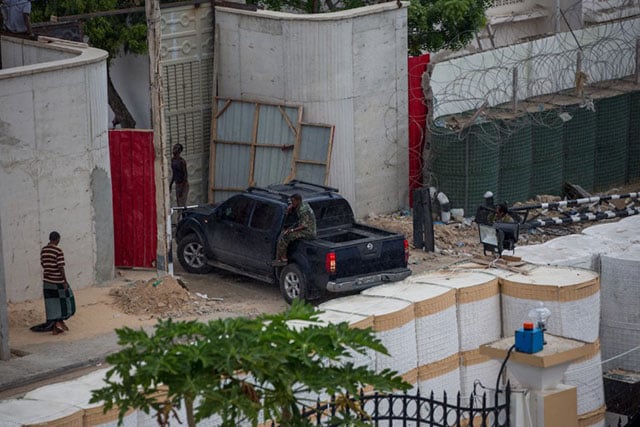 Security precautions near Al Jazaara Palace hotel. (Photo: Jan Wellmann)The official reason for the US presence in Somalia is the perennial war against terrorism. Since 2011, there has been a glut of drone attacks against al-Shabab in Somalia. In June 2011, CIA director John Brennan declared, “From the territory it controls in Somalia, al-Shabab continues to call for strikes against the United States. As a result we cannot and we will not let down our guard. We will continue to pummel al-Qaeda and its ilk.”
Security precautions near Al Jazaara Palace hotel. (Photo: Jan Wellmann)The official reason for the US presence in Somalia is the perennial war against terrorism. Since 2011, there has been a glut of drone attacks against al-Shabab in Somalia. In June 2011, CIA director John Brennan declared, “From the territory it controls in Somalia, al-Shabab continues to call for strikes against the United States. As a result we cannot and we will not let down our guard. We will continue to pummel al-Qaeda and its ilk.”
It’s hard to fathom, however, how a ragtag rebel group that can barely hold a village in Somalia could threaten the United States today.
A better rationale for the US presence in Somalia is its geostrategic location at the mouth of the Red Sea, with passage to the Suez Canal and close proximity to Yemen, Saudi Arabia and Iran, the hotbed of Middle East affairs.
The real reason is oil.
The Energy Equation
Somalia holds some of the world’s most underexploited oil and gas reserves in the world. In the 1980s, geologists from the Texas-based Hunt Oil Company (with close ties to the Bush family) predicted a capacity of a billion barrels of oil lodged in an underground rift that stretched from Yemen to Somalia. President George H.W. Bush inaugurated the Hunt Yemen distillery in 1986, with a speech emphasizing “the growing strategic importance to the West of developing crude oil sources in the region away from the Strait of Hormuz.”
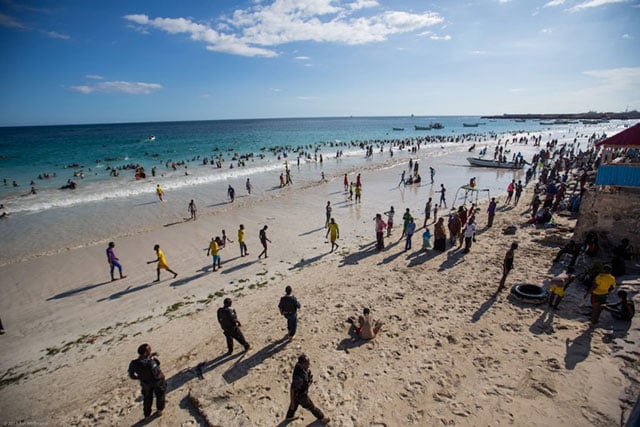 Mogadishu Lido Beach is part of a 3,300-km long coastline, the longest of mainland Africa and the Middle East. (Photo: Jan Wellmann)Before the civil war erupted in 1990, nearly two-thirds of Somali energy reserves were already allocated to the US oil giants Conoco, Amoco, Chevron and Phillips. But Mohamed Siad Barre, president and military dictator of the Somali Democratic Republic, was not willing to give the entire pie to the Americans.
Mogadishu Lido Beach is part of a 3,300-km long coastline, the longest of mainland Africa and the Middle East. (Photo: Jan Wellmann)Before the civil war erupted in 1990, nearly two-thirds of Somali energy reserves were already allocated to the US oil giants Conoco, Amoco, Chevron and Phillips. But Mohamed Siad Barre, president and military dictator of the Somali Democratic Republic, was not willing to give the entire pie to the Americans.
Siad Barre, or Comrade Siad, came into power in 1969 with a coup d’état. Barre was a military dictator who wanted to reassemble Somalia after half a century of colonialism. He was also a socialist who used cooperatives to build roads and hospitals and reinvigorate local agriculture. He nationalized banks, industries and businesses under the new Somali Democratic Republic. Barre’s mission was to build a Greater Somalia to unite ethnic Somalis who had been ripped apart by British, French and Italian troops since 1881, when European powers partitioned more than 90 percent of the African continent.
By the time Barre got into power, the old Somalia was fractured under five independent territories: Italian Somalia (South), French Somalia (Djibouti), Ethiopian Somalia, British Somaliland and Kenyan Somalia (North Eastern Districts). Barre’s attempt to reacquire the Ethiopian-controlled Ogaden territory failed in 1977 after the Soviets flipped their support from Barre to Ethiopia. This gave an opening to the Americans, who began to support the Barre government with $100 million per year in “economic and military aid.”
While Texans were running around like wily coyotes in the 1980s, tagging Somalia’s oil reserves, it became increasingly obvious that Barre would not become their puppet leader. Ergo, the Americans adopted a classic divide-and-conquer strategy, firstly by befriending a rebel group out of Somaliland, the Somali National Movement, which was hell-bent on taking out Barre. Other rebel groups followed suit. Some historic accounts of this time label Barre as a ruthless military dictator, opposed by the people. But the real thrust against him came from tribal groups who fired from every cardinal direction of the compass to create chaos, with CIA backing.
By 1988, Barre was fighting to keep control of Mogadishu. By 1991, he’d been ousted and Somalia was declared “a failed state.” The resulting power vacuum intensified the war, collapsing distribution, infrastructure and agriculture. The result was one of the deadliest famines on record. From 1991 to 1992, half of the population of Somalia was starving.
It was the perfect time for the cavalry to come to the rescue.
Black Hawk Down
After a failed attempt in 1991 by UN troops to broker a cease-fire between the tribal groups, the United States offered to lead a “humanitarian operation” headed by the UN Security Council. Their aim was to reach a resolution, utilizing “all necessary means” to ensure relief efforts.
Readily deployed news crews captured the US Marines landing on the beaches of Somalia on December 9, 1992. The operation was code-named “Operation Restore Hope.”
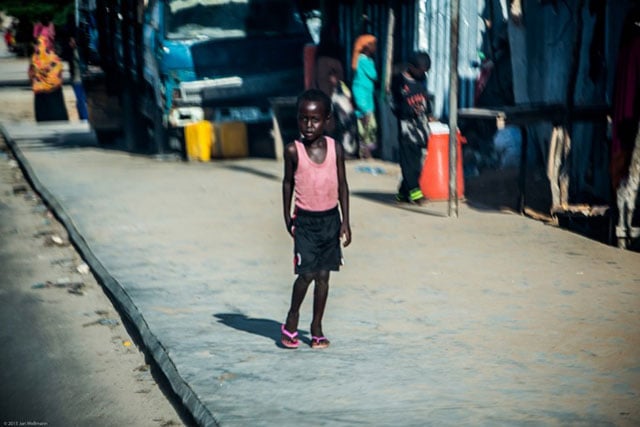 Little girl in Bakaara Market, Mogadishu. (Photo: Jan Wellmann)Enter Gen. Mohamed Farrah Aidid, Barre’s former adviser, intelligence chief and ambassador to India. Educated in Rome and in an elite military institute in Moscow, he was revered by many Somalis as a fiercely nationalistic, charismatic soldier who fought in the trenches and was determined to resist a US-led occupation. As leader of one of the largest opposition groups, the United Somali Congress, Aidid was perfectly positioned to inherit Barre’s mantle.
Little girl in Bakaara Market, Mogadishu. (Photo: Jan Wellmann)Enter Gen. Mohamed Farrah Aidid, Barre’s former adviser, intelligence chief and ambassador to India. Educated in Rome and in an elite military institute in Moscow, he was revered by many Somalis as a fiercely nationalistic, charismatic soldier who fought in the trenches and was determined to resist a US-led occupation. As leader of one of the largest opposition groups, the United Somali Congress, Aidid was perfectly positioned to inherit Barre’s mantle.
But Aidid’s vision was contrary to US interests.
“You are doing God’s work,” President Bush told his 26,000 Army and Marine troops who were headed to Somalia. “We will not tolerate armed gangs ripping off their own people.”
As the only US president in history to visit a sub-Saharan nation during a conflict, Bush spent two nights on the carrier USS Tripoli offshore from Mogadishu, trying to negotiate a deal with Aidid. The attempt was a failure.
Aidid was a diehard for independence and a Greater Somalia. As the main obstacle for US dominance in the region, he quickly landed on top of the US kill list. But due to tip-offs from US Marines of Somali ethnicity loyal to Aidid’s ideology, most of the covert attacks against him failed.
In Ridley Scott’s film Black Hawk Down, which was based on true events, Aidid the warlord has to be captured because he’s starving his people. For the Somalis, the Black Hawks landing in Bakara Market represented a century of colonialism. It was no surprise that 20,000 Somalis or more converged on US Army Rangers with stones, rocket-propelled grenades and AK-47s. Eighteen Americans and some 3,000 Somalis died in less than one day in the fight for Mogadishu, to the tune of Hans Zimmer.
The bungled operation forced President Bill Clinton to pull out of Somalia in 1993 – but only in official capacity. The real war was just about to begin.
Masters of Chaos
After the US Marines bailed out, Aidid became infamous. He declared himself president in 1995, but despite having enough sway to unite the country, a Western-orchestrated conference in Djibouti elected its own president, Ali Mahdi Mohamed.
Aidid’s right-hand man, Osman Ali Atto, who happened to be the manager of a US oil company, allied himself with Mahdi’s forces and orchestrated Aidid’s defeat. Aidid was fatally wounded in the ensuing battle (Ali Atto later became the biggest land owner in Somalia).
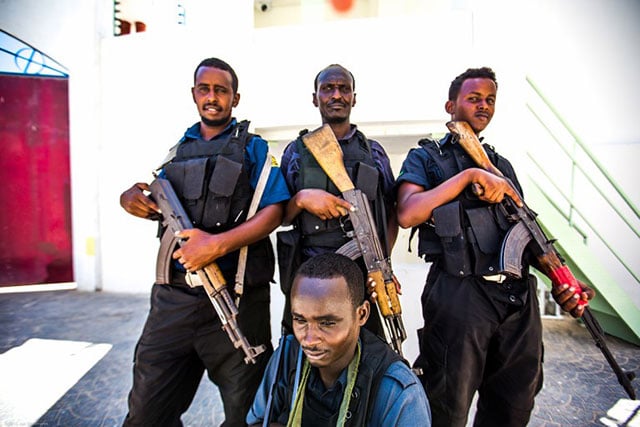 Private guards during a lunch break in Mogadishu. (Photo: Jan Wellmann)For the next decade, various rulers were able to control only parts of Mogadishu, while factional fighting continued in the rest of the country. Another record famine took place in 1998. A Transitional National Government was formed in 2000 in Djibouti, but was instantly opposed by Somali Islamists who united under the Islamic Courts Union (ICU). In reaction to the growing influence of the ICU, a group of Mogadishu warlords formed the Alliance for the Restoration of Peace and Counterterrorism (ARPCT) – with CIA funding ($100,000 to $150,000 per month, according to the International Crisis Group).
Private guards during a lunch break in Mogadishu. (Photo: Jan Wellmann)For the next decade, various rulers were able to control only parts of Mogadishu, while factional fighting continued in the rest of the country. Another record famine took place in 1998. A Transitional National Government was formed in 2000 in Djibouti, but was instantly opposed by Somali Islamists who united under the Islamic Courts Union (ICU). In reaction to the growing influence of the ICU, a group of Mogadishu warlords formed the Alliance for the Restoration of Peace and Counterterrorism (ARPCT) – with CIA funding ($100,000 to $150,000 per month, according to the International Crisis Group).
In 2006, despite CIA support, the ICU defeated the ARPCT in what is known as the “Second Battle of Mogadishu.” Sheikh Sharif Sheikh Ahmed, ICU’s chairman, managed to seize Mogadishu, but his progress was quickly reversed when Ethiopian forces – again with US backing – joined the melee against the ICU. When a weaker Sharif began to look for a deal with the transitional government, the extreme factions of the ICU splintered off in the form of al-Shabab. The group’s first target was their former leader, Sharif, who proceeded to jump over to the side of the United States. Sharif got a warm welcome from the Americans, with dual residence and education in the United States and the United Kingdom, along with four wives.
US drone operators have, from the beginning, only targeted al-Shabab members who are not aligned with US interests.
Al-Shabab is an evolution of al-Itihaad al-Islamiya (IAIA) – a group of militants originally funded by Osama bin Laden to secure an Islamist state in the Horn of Africa – after the fall of the Barre regime. Extremist IAIA leaders trained young jihadists in Afghanistan and imported them back to Somalia. One of them was Aden Hashi Farah Ayro, who came back to Somalia in 2003 to lead the Somali al-Shabab faction. Ayro was said to have the mentality of Aidid, which would have made him particularly interesting to Americans. In 2008, Ayro was taken out by a US drone in central Somalia, along with up to 30 civilians.
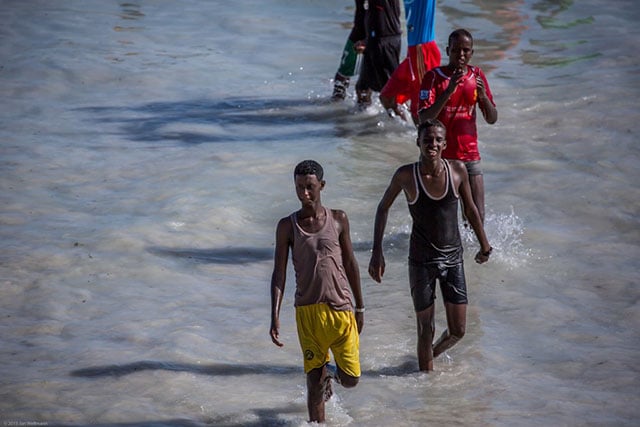 Young Somali’s on Mogadishu beach. (Photo: Jan Wellmann)Yet at the same time, Somali sources claim that al-Shabab was receiving support from Ethiopia via the United States. Why were US drones being so selective?
Young Somali’s on Mogadishu beach. (Photo: Jan Wellmann)Yet at the same time, Somali sources claim that al-Shabab was receiving support from Ethiopia via the United States. Why were US drones being so selective?
The answer may once again lie in the mastery of chaos. Impossible to corroborate, yet possible to fathom, US drone operators have, from the beginning, only targeted al-Shabab members who are not aligned with US interests.
Another al-Shabab leader who supposedly failed to cooperate with Americans was Ahmed Abdi Godane, who was also taken out by a drone in 2014. He was replaced by al-Shabab’s current leader, Ahmed Omar. Since 2007, there have been about 19 drone attacks in Somalia.
While the war raged on for a second decade, in 2010, Somalia entered its third record famine. By then, an entire generation of Somalis had either fled or died.
Mogadishu has since been repopulated with a predominantly young, once-rural population that fled the countryside to look for any means of survival. Today, the educated class, the leaders and the dreamers are dead, along with the idea of an independent Somalia – an opportune outcome for the masters of chaos and Big Oil.
The Final Grab
On my last night in Mogadishu, another black bird roared over Jazeera Palace Hotel at 4 am. This time, the rumble sounded more somber. I was sleepless again, pacing the room, feeling trapped inside a sardine can – an apt analogy for Somalia’s own situation. Maybe the country had been canned purposely, waiting for the right time to be rolled open, I couldn’t help wonder.
There were countless clues to support such a containment tactic. All efforts to rebuild had fallen apart for consecutive years, despite several attempts by foreign nations and corporations to help Somalia. Foreign delegations were either rejected or, like the Chinese mission, conveniently became victims of terrorist attacks.
How deep does the wormhole reach down in Somalia today?
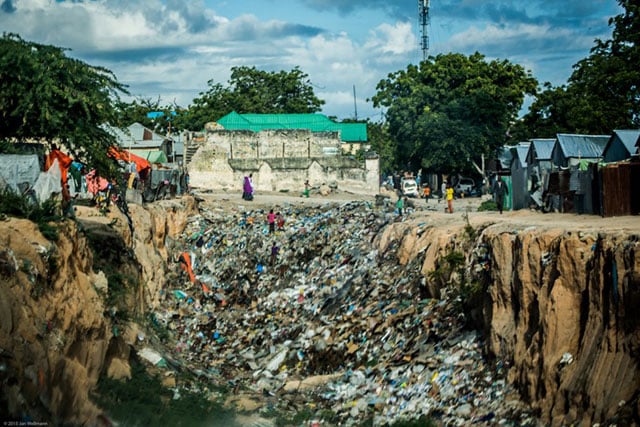 Children searching a waste landfill in the center of Mogadishu. (Photo: Jan Wellmann)The current Somali president is Hassan Sheikh Mohamud, a Western favorite who was listed by Time magazine as one of the 100 most influential people in the world, known for his “national reconciliation, anti-corruption measures, socio-economic and security sector reforms.” UK Prime Minister David Cameron and the US government have applauded him.
Children searching a waste landfill in the center of Mogadishu. (Photo: Jan Wellmann)The current Somali president is Hassan Sheikh Mohamud, a Western favorite who was listed by Time magazine as one of the 100 most influential people in the world, known for his “national reconciliation, anti-corruption measures, socio-economic and security sector reforms.” UK Prime Minister David Cameron and the US government have applauded him.
My sources call Mohamud “the most corrupt president in the history of Somalia.” The word is that Qatar fleshed out $20 million to put him in power. Qatar, in turn, plays the flute for Big Oil.
Mohamud comes from a small rural town, with a degree in technology and minor training at the Center for Justice and Peacebuilding in Harrisonburg, Virginia. In 2011, Mohamud established the Peace and Development Party, and a year later, was promptly elected as the country’s president, as if preordained for the position. There hasn’t been much peace or development in Somalia since.
The locals have not seen a single cent of the $2 billion in aid promised by the World Bank. An $800 million offer by Malaysia to build a power plant as a relief effort was rejected by the president. While Mohamud is stalling several international relief efforts to help the country, the rumor is that his brother drives around Mogadishu in a black limo, buying real estate properties with bags of cash.
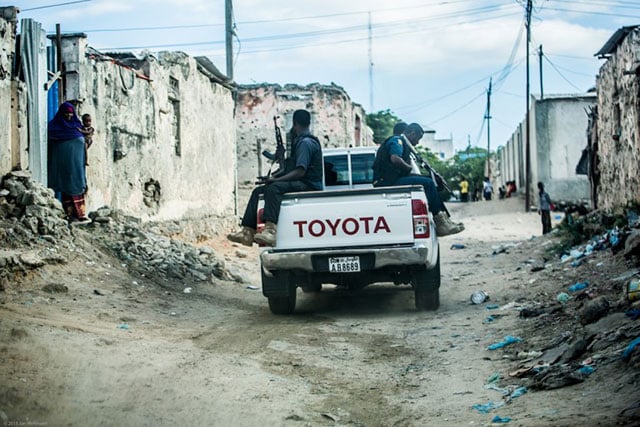 Mother with a baby on a street and our security convoy in Mogadishu. (Photo: Jan Wellmann)Mohamud works closely with the Somali National Security Agency, putting him in close quarters with US intelligence. He was also accused of trying to steal $420 million from a Swiss bank account set up by the Barre government. But the Western favorite remains cocooned in power, with the prime minister and cabinet all belonging to his small circle of family, friends and allies.
Mother with a baby on a street and our security convoy in Mogadishu. (Photo: Jan Wellmann)Mohamud works closely with the Somali National Security Agency, putting him in close quarters with US intelligence. He was also accused of trying to steal $420 million from a Swiss bank account set up by the Barre government. But the Western favorite remains cocooned in power, with the prime minister and cabinet all belonging to his small circle of family, friends and allies.
While the country prepares for a “democratic” election campaign slated for the summer of 2016 – without a population registry, roadways, electricity or communication infrastructure – Western oil interests are completing new seismic surveys off the coast of Somalia.
Most of the Somali entrepreneurs I met during my four-day visit see through the facades. They are exceptionally smart, resilient men and women. They hear the same black birds at night. They know the history. They’ve lost most of their family and friends. Yet they are driven to try, once again, to build on the ruins.
They remember the Mogadishu that once was, before the black birds arrived.
Join us in defending the truth before it’s too late
The future of independent journalism is uncertain, and the consequences of losing it are too grave to ignore. We have hours left to raise the $12,0000 still needed to ensure Truthout remains safe, strong, and free. Every dollar raised goes directly toward the costs of producing news you can trust.
Please give what you can — because by supporting us with a tax-deductible donation, you’re not just preserving a source of news, you’re helping to safeguard what’s left of our democracy.